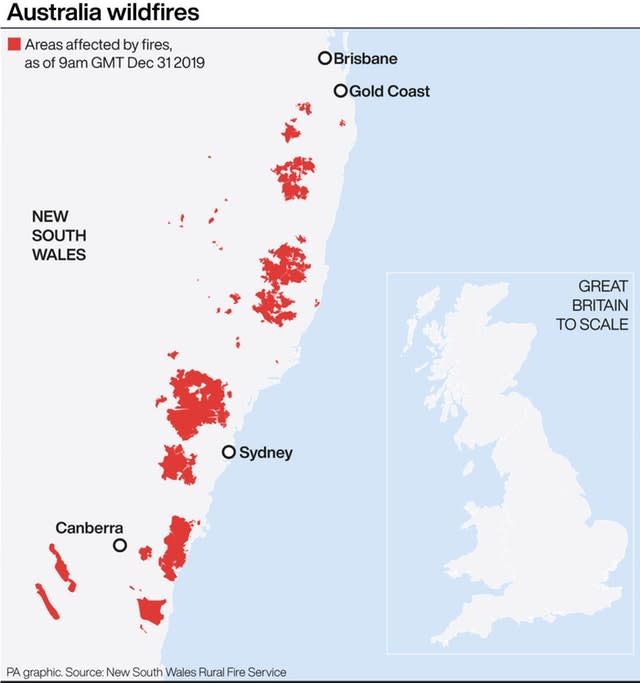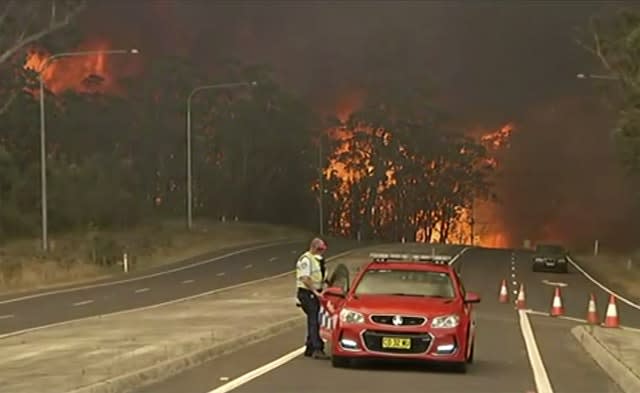Raging wildfires trap 4,000 on Australian town’s waterfront
Wildfires burning across Australia’s two most populous states have trapped residents of a seaside town in apocalyptic conditions, destroyed many properties and caused at least two deaths.
About 12.35 million acres of land have burned nationwide during the wildfire crisis, with 12 people confirmed dead and more than 1,000 homes destroyed.
Nearly 100 fires are burning across the state of New South Wales, which is home to Sydney.
Australia’s annual wildfire season, which peaks during the Southern Hemisphere summer, started early after an unusually warm and dry winter. Record-breaking heat and windy conditions triggered devastating wildfires in New South Wales and Queensland states in September.
New South Wales Rural Fire Services Commissioner Shane Fitzsimmons said this wildfire season is the worst on record and painted a bleak long-term picture.
“We’ve seen extraordinary fire behaviour,” he said on Tuesday. “What we really need is meaningful rain, and we haven’t got anything in the forecast at the moment that says we’re going to get drought-breaking or fire-quenching rainfall.”
At 3am on 1 January 2020, there are 112 fires burning across NSW. Several large & dangerous fires continue burning on the South Coast where 2 fires remain at emergency warning. A further 6 fires are at Watch and Act. Over 2500 firefighters continue working on these fires. #nswrfs pic.twitter.com/5wgY6UnjOD
— NSW RFS (@NSWRFS) December 31, 2019
The crisis has reignited debate about whether prime minister Scott Morrison’s conservative government has taken enough action on climate change. Australia is the world’s largest exporter of coal and liquefied natural gas.
Mr Morrison, whom critics have deemed a climate change sceptic, conceded earlier this month that “climate change along with many other factors” has contributed to the wildfires.
Late on Tuesday, Mallacoota was saved by changes of wind direction, but authorities said “numerous” homes were lost.

Residents returning home were urged to boil tap water before drinking it. Forest Fire Management Victoria said the wildfires had put heavy demands on tap water which is affecting the supply.
Stranded residents and holidaymakers were reported to be sleeping in cars on New Year’s Eve, while petrol stations and surf clubs transformed into evacuation areas.
Victoria state premier Daniel Andrews had earlier announced plans to evacuate the people trapped by sea, and there were grave fears for four missing people. “We can’t confirm their whereabouts,” Mr Andrews told reporters.
He has requested assistance from 70 firefighters from the US and Canada, while Australia’s military sent air and sea reinforcements.
Given the severity of the current fires and the scale of the recovery effort, we're establishing a Bushfire Response and Recovery Taskforce. It will coordinate State Government agencies and cut any red tape – so we can get relief where it's needed faster.https://t.co/0C2kZUq5Dq
— Dan Andrews (@DanielAndrewsMP) December 31, 2019
Victoria Emergency Services Commissioner Andrew Crisp confirmed “significant” property losses across the region. More than 115 communities across Victoria remained under emergency warnings on Tuesday night.
Some communities cancelled new year fireworks celebrations, but Sydney’s popular display over its famous harbour controversially went ahead in front of more than a million revellers. The city was granted an exemption to a total fireworks ban to prevent new wildfires.
Fire conditions worsened in Victoria and New South Wales after oppressive heat on Monday mixed with strong winds and lightning.

Police in New South Wales said on Tuesday that two men — a 63-year-old father and 29-year-old son — died in a house in the wildfire-ravaged south-east town of Cobargo, and a 72-year-old man remains missing.
“They were obviously trying to do their best with the fire as it came through in the early hours of the morning,” New South Wales Police Deputy Commissioner Gary Worboys said.
“The other person that we are trying to get to, we think that person was trying to defend their property in the early hours of the morning.”
On Monday, a firefighter was killed when extreme winds overturned his truck. Samuel McPaul, 28, was the third volunteer firefighter in New South Wales to have died in the past two weeks. He was an expectant father.
More than 130 fires remain burning across New South Wales, with five at an emergency level. Authorities warned that power would be out for 24 hours along the fire-ravaged south coast of the state.

 Yahoo News
Yahoo News 
